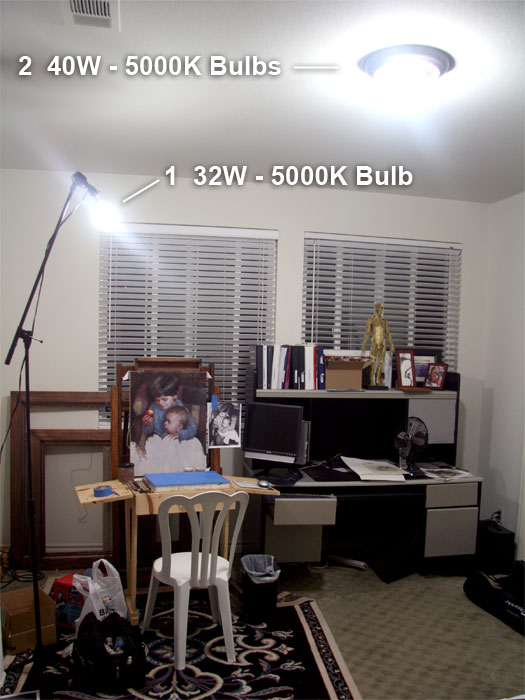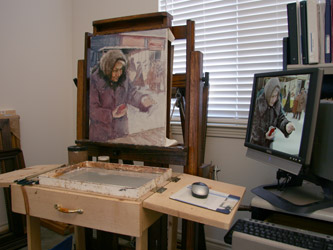When you venture into the confusing world of painting, one of the first things you need to put some thought into is your studio space. Working in a poor environment can really hurt your performance.
My Ideal Art Studio
One of my big dreams and goals in life is to have a gigantic art studio to brag about. Here’s my vision of the perfect art studio.
- North light coming from above and plenty of artificial light for painting at night
- High Ceilings
- Enough space for a model stand, large easel arrangement, library, area to keep all the supplies and artwork, a couch, fridge, and a Nordstrom pianist.
- Large monitor next to my easel for reference.
- Far away from any noise and distraction
- Lots of wall space to hang inspirational artwork
- Ventilation
- Surround Sound Audio System
For now, most of us have to work with limited space and funds. If you don’t have the luxury of a large room to setup your art studio, you’ll have to get creative and work with what you’ve got.
“But I don’t even have enough room to put my easel!” You’re gonna have to make some sacrifices. Ever think about selling your TV (use the money for some art supplies) and using that space for your easel? Try to do as much as you can with the resources you’ve got. If you’re really serious, you will find a way! Most of us have to adjust and adapt to what’s available in our house/apartment, but there’s a few important things to think about when setting up an art studio: properly lighting the studio and the placement of your reference photos.
Properly Lighting the Studio
For the longest time, I painted in a room with warm light bulbs and a south-facing window directly behind me. Even if the window is facing north, that’s probably the worst lighting you can have, excluding complete darkness. Any kind of light source behind you will reflect in the painting. I used to always be able to see my own silhouette in my paintings. Ideally, you want north light coming from above.
Why north light?
That way, you never get direct sunlight coming into the room. If you setup a still life or a model in the studio, the lighting will stay somewhat constant throughout the day. If you have direct sunlight coming in, the lighting will change as the sun moves. You don’t want any direct light hitting the canvas either. This creates very strong highlights on the paint and can be very distracting. The white of the canvas and the palette will reflect the sunlight and cause glare. Too much of this UV exposure can’t be good for your eyes! Plein air painters experience this ‘snowblindness’ a lot when not painting in the shade. North light is very soft and bounces around the walls of the room to illuminate everything evenly.
Why from above?
Because you don’t want any distracting reflections in the painting. Think of the painting as a mirror. The wet paint will reflect any bright objects behind you. It might even be a doorway with some light coming in. You can have north facing windows that are not up high, but you’ll need to face the easel away from the windows and add some artificial light.
If Needed, Add Artificial Light

It’d be nice to have high north facing windows, but most of us don’t really have a choice where our windows are. So, what do you do when you have south facing windows or windows that aren’t high up?
South facing windows
I say close them completely to get rid of the sun. Get some nice curtains and use artificial light.
Low north facing windows
This is what I have in my art studio. I turned my easel to face away from the windows. I don’t want to see the reflection of the windows in my painting. In addition, I added some artificial light.
Adding Artificial Light to the Art Studio
For more information about light bulbs, read my tutorial on Choosing a Light Bulb for Your Art Studio. Currently, I’m using some heavy duty CFL bulbs with a total of 112 Watts and 5000 Kelvin color temperature. Like windows, the bulbs have to be elevated above the easel to prevent seeing the reflection in the painting. They should be far enough from the easel as not to create a hot-spot on the canvas. Table lamps or lamps that clamp on to the easel don’t work very well. My current setup works great for me whether I’m painting in the morning, afternoon, or late at night.
I bought my bulbs at 1000Bulbs.com. They have CFL’s ranging from 2 to 200 Watts, with a good CRI rating, 5000K color, and great prices.
Placement of Reference Photos

Try to keep your reference close to the painting to easily compare the two. Also, make sure the reference is angled directly at you to prevent perspective distortion.
Using printed photos works fine, but I prefer to paint from my monitor for several reasons:
1. Quality
For the same reason that making a copy of a copy isn’t as good as the original, printing the photos isn’t as good as working from the monitor. Every time you convert the information from one media to another you lose quality and detail. Working from life is the best reference, but most of us don’t have that privilege, so we convert life into a photograph and we lose a little bit of quality. Then if you decide to print the photograph, again you lose a little bit of quality. Depending on how good your camera and printer is determines how much quality we lose from the original source (life).
2. Convenience and Organization
Sometimes I have multiple reference photos that I use to composite into one painting. On my computer, I can easily switch from photo to photo as I need to. I don’t need to hang all the photographs around my easel.
3. Zoom in and out
When needed, I can zoom into a specific area I’m working on and get even more detail. I only use this in areas where I want to get a lot of detail such as the head and hands. I try to avoid this in background elements because its very easy to get caught up in all the details.
If you can’t work from a monitor, then make sure you use high quality photo reference. Kinko’s has self service stations where you can print color photos 8.5 x 11 for about $1.